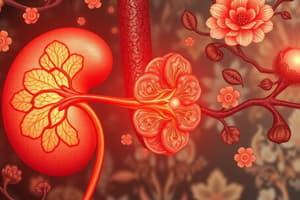Podcast
Questions and Answers
What happens to the production of ADH as the water potential of the blood increases?
What happens to the production of ADH as the water potential of the blood increases?
- It decreases. (correct)
- It stays the same.
- It fluctuates dramatically.
- It increases.
What effect does less ADH have on the collecting duct?
What effect does less ADH have on the collecting duct?
- It loses more water by osmosis.
- It produces more urine.
- It becomes more permeable.
- It becomes less permeable. (correct)
What is the primary role of dialysis tubing in the dialysis machine?
What is the primary role of dialysis tubing in the dialysis machine?
- To generate electricity.
- To maintain body temperature during the process.
- To allow small molecules to diffuse. (correct)
- To allow large proteins to pass through.
Why is fresh dialysis fluid used in a dialysis machine?
Why is fresh dialysis fluid used in a dialysis machine?
What role does negative feedback play in the body?
What role does negative feedback play in the body?
How does temperature affect the rate of diffusion in dialysis?
How does temperature affect the rate of diffusion in dialysis?
What happens to glucose in the dialysis process?
What happens to glucose in the dialysis process?
What is the purpose of using a large number of strands of dialysis tubing?
What is the purpose of using a large number of strands of dialysis tubing?
What role does anti-diuretic hormone (ADH) play in the kidneys?
What role does anti-diuretic hormone (ADH) play in the kidneys?
What happens when the water potential in blood is lower than the set point?
What happens when the water potential in blood is lower than the set point?
What is one effect of increased permeability of the collecting duct?
What is one effect of increased permeability of the collecting duct?
Which treatment can help manage kidney failure?
Which treatment can help manage kidney failure?
What structure in the kidney does ADH act upon to control water reabsorption?
What structure in the kidney does ADH act upon to control water reabsorption?
What would a low-protein diet aim to achieve in kidney management?
What would a low-protein diet aim to achieve in kidney management?
How do aquaporins contribute to the function of the collecting duct?
How do aquaporins contribute to the function of the collecting duct?
What occurs when the collecting duct moves through a hypertonic region?
What occurs when the collecting duct moves through a hypertonic region?
Flashcards
ADH function
ADH function
Anti-diuretic hormone (ADH) controls the permeability of the collecting duct to water.
Collecting Duct Permeability
Collecting Duct Permeability
The collecting duct's ability to let water pass through its walls is controlled by hormones, like ADH.
Osmoreceptors
Osmoreceptors
Specialized cells in the hypothalamus that detect changes in blood water potential.
Aquaporins
Aquaporins
Signup and view all the flashcards
Concentrated Urine
Concentrated Urine
Signup and view all the flashcards
ADH Release
ADH Release
Signup and view all the flashcards
Kidney Failure Treatments
Kidney Failure Treatments
Signup and view all the flashcards
Hypertonic Medulla
Hypertonic Medulla
Signup and view all the flashcards
ADH and water potential
ADH and water potential
Signup and view all the flashcards
Dialysis membrane
Dialysis membrane
Signup and view all the flashcards
Dialysis fluid
Dialysis fluid
Signup and view all the flashcards
Counter-current flow
Counter-current flow
Signup and view all the flashcards
Negative feedback
Negative feedback
Signup and view all the flashcards
Dialysis tubing surface area
Dialysis tubing surface area
Signup and view all the flashcards
Dialysis temperature
Dialysis temperature
Signup and view all the flashcards
Collecting duct permeability
Collecting duct permeability
Signup and view all the flashcards
Study Notes
Collecting Duct and ADH
- Anti-diuretic hormone (ADH) controls collecting duct permeability to water. More permeable = more water reabsorbed, less excreted as urine.
- Lower blood water potential triggers ADH release from the posterior pituitary gland.
- ADH receptors on collecting duct cells trigger aquaporin vesicle fusion to membrane.
- Water moves into cells by osmosis, increasing blood water potential.
- Low volume, concentrated urine results.
- As blood water potential rises, ADH production decreases, leading to less permeable collecting ducts and dilute urine.
- This process is a negative feedback loop.
Kidney Failure Treatments
- Medication controls electrolytes (K+, Ca2+).
- Low-protein diet reduces excess amino acids (and thus urea).
- Lowering blood pressure using medicine.
- Dialysis removes wastes from blood.
- Kidney transplant replaces a failing kidney.
Dialysis
- Temperature (40°C) improves diffusion rates to maintain body temperature.
- Large surface area of dialysis tubing for increased diffusion.
- Semipermeable membrane (dialysis tubing) filters out small molecules (e.g., urea, water, salts).
- Dialysis fluid has no urea to prevent urea movement out of blood.
- No concentration gradient for glucose (thus it doesn't leave blood).
- Fresh dialysis fluid maintains the concentration gradient.
- Countercurrent flow of blood and fluid optimizes the concentration gradient.
Studying That Suits You
Use AI to generate personalized quizzes and flashcards to suit your learning preferences.




